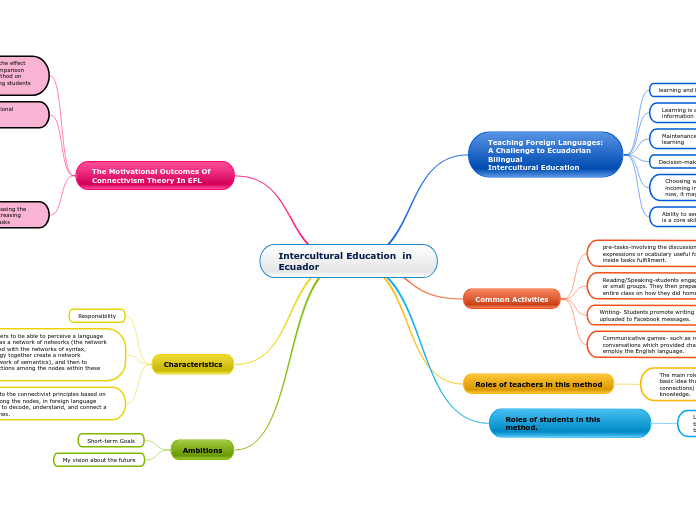Intercultural Education in Ecuador
Teaching Foreign Languages: A Challenge to Ecuadorian Bilingual
Intercultural Education
learning and knowledge are based on the diversity of opinions;
Learning is a process of connecting specialized nodes or information sources.
Maintenance of connections is important for continuous learning
Decision-making is a learning process itself.
Choosing what to learn and the meaning of
incoming information.While there is a right answer
now, it may be wrong tomorrow due to alterations
Ability to see connections between fields, ideas, and concepts is a core skill.
Common Activities
pre-tasks-involving the discussion on video clips and idiomatic expressions or ocabulary useful for the main outside and inside tasks fulfillment.
Reading/Speaking-students engage in speech activity in pairs or small groups. They then prepare an oral report for the entire class on how they did homework.
Writing- Students promote writing through drafts to be uploaded to Facebook messages.
Communicative games- such as role plays and conversations which provided chances for students to employ the English language.
Roles of teachers in this method
The main role of the teacher is not to forget about Siemens’ basic idea that the ability to learn (create and understand connections) is more important than the current mount of knowledge.
Roles of students in this method.
Learner at the centre of the learning experience rather than the educator. Learner's ability to see or form connections between fields, ideas, and concepts is a core skill.
The Motivational Outcomes Of Connectivism Theory In EFL
The purpose of this study was to examine the effect of connectivism instructional method in comparison witH communicative language teaching method on academic self-efficacy and task value among students in EFL.
The results showed the connectivism instructional method was significantly more effective than communicative language teaching method
Method provide unique opportunities for increasing the self-efficacy and task value of students by increasing social intractions and diversity for choosing tasks
Self-efficacy specifically refers to student’s beliefs about their ability to successfully complete academic
For example, in online learning environments concluded that a high academic self-efficacy in learners leads to their better use of online learning environments.
Connectivism is the thesis that knowledge is distributed across a network of connections, and therefore
that learning consists of the ability to construct and traverse those networks.
This theory claims to have made new developments through the attention to the effects of the advent of the digital era, in the field of education and learning in general and teaching and learning of EFL in particular.
Characteristics
Responsibility
It is important for learners to be able to perceive a language not as a structure, but as a network of networks (the network of morphology connected with the networks of syntax, lexicology, and phonology together create a network connected with the network of semantics), and then to comprehend the connections among the nodes within these networks.
As learning is according to the connectivist principles based on creating connections among the nodes, in foreign language education it is important to decode, understand, and connect a new node with the old ones.
Ambitions
Short-term Goals
My vision about the future
